Teddy Bears Over Toasters: Or, Philip C. Stead
Visits and Brings His Own Kickin’ Coffee Mug
 April 11th, 2011 by jules
April 11th, 2011 by jules
That day Jonathan walked to the old wharf alone.”
(Click to enlarge illustration.)
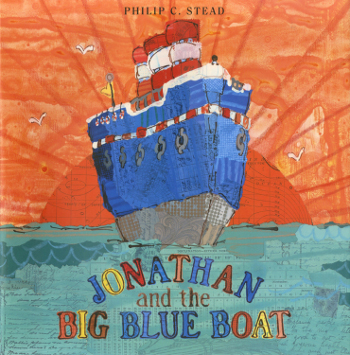 So, here’s the deal on this early Monday morning at Camp 7-Imp, dear readers. I can say with a moderate amount of confidence that it almost doesn’t matter what I post here at 7-Imp for the rest of 2011, that this will quite likely be my favorite post. No, really. The Great One himself, Sendak, could stop by, and I might actually be all, well, there was that great Jonathan post with Philip C. Stead. (Allright, since it’s Sendak—hypothetically here—the posts may tie for Best 2011 Visits, but you get the idea.)
So, here’s the deal on this early Monday morning at Camp 7-Imp, dear readers. I can say with a moderate amount of confidence that it almost doesn’t matter what I post here at 7-Imp for the rest of 2011, that this will quite likely be my favorite post. No, really. The Great One himself, Sendak, could stop by, and I might actually be all, well, there was that great Jonathan post with Philip C. Stead. (Allright, since it’s Sendak—hypothetically here—the posts may tie for Best 2011 Visits, but you get the idea.)
And here’s why: First of all, I love this new picture book from Stead. More on that in a minute. But also, I love that Phil took the time to compose this post, to share images of not only his illustrations, but his process, the steps it takes to get from point A to point B. Perhaps it’s expressly because I’m not an illustrator that I find that so fascinating, but I do. His wife, Erin—also an illustrator and 2011 Caldecott medalist for A Sick Day for Amos McGee, which Phil penned—did the same back in ’09 when I first saw her work (and knew it screamed SPECIALNESS). She actually visited twice to talk about Amos McGee, but it was this July ’09 post, in which she shared her printmaking process for the book (before it was even out), that I so enjoyed. I appreciate that both of them slow down (I emphasize this, seeing as how we live in a 140-character, hyper-hypo, shortened-attention-span world anymore) and take the time to share in such a detailed manner how they create their magic. (They humbly do not call it “magic,” to be clear, but I can. And do.)
Really, I give long interviews to some illustrators who don’t get as detailed as Phil does below, after I simply said, tell me about making this book. (And why exactly have I not had a breakfast interview with him or Erin? I’ll have to fix that one day.) And Phil gets detailed in the way I like — succinctly-worded and letting the art do most of the talking. As it should be.
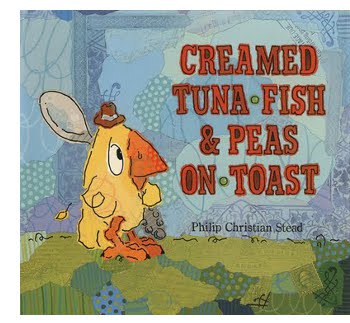 And this book? Jonathan and the Big Blue Boat, both written and illustrated by Phil, also exudes specialness. In June of 2009, Phil actually gave me a (very) early sneak-peek at this title, when he stopped by to share some illustrations from Creamed Tuna Fish and Peas on Toast, his debut title from that year. Jonathan—to be released in June by Roaring Brook—both celebrates and treasures That Which We Too Easily Discard (and Disregard) In This World. And it’s a beautiful tale.
And this book? Jonathan and the Big Blue Boat, both written and illustrated by Phil, also exudes specialness. In June of 2009, Phil actually gave me a (very) early sneak-peek at this title, when he stopped by to share some illustrations from Creamed Tuna Fish and Peas on Toast, his debut title from that year. Jonathan—to be released in June by Roaring Brook—both celebrates and treasures That Which We Too Easily Discard (and Disregard) In This World. And it’s a beautiful tale.
Tragically—as you can see in the opening spread and accompanying text—young Jonathan’s parents arbitrarily decide he’s too old for his teddy bear. Probably because I’m a children’s librarian, this brings to mind the current you’re-old-enough-now-to-discard-picture-books trend amongst some parents and educators, those that push children at younger ages to graduate to chapter books, but I suppose I digress. But does Jonathan’s predicament remind me of our tendency these days to overschedule our kids, to make them grow up faster, to push them to be bigger and better this-and-that before they’re ready? Why, yes it does. After all, his parents trade something he loves in his childhood for something “useful” that lots of grown-ups use. Am I reading too much symbolism into it? Perhaps. Either way, poor Jonathan was really rather attached to Frederick, his very best friend.
I don’t want to give away this book’s entire plot—I can’t recommend highly enough that you get your own copy, by hook or by crook, to take in the story and artwork. Suffice it to say that Jonathan ends up on the Big Blue Boat he loves to visit at the old wharf, and he’s off to find Frederick. Along the way, he meets a goat, an elephant too old for the circus, some pirates, a lonely whale, and a little girl from behind a shop counter. All of them—save the pirates, mind you—join Jonathan on his adventure to locate his beloved Frederick.
Stead’s intricate collage art gets me each time, and I find myself poring over it for long periods of time, neglecting things like work and dishes and feeding the creatures in my home. Well, there’s only been Creamed Tuna Fish thus far, but I fell for that one hard and fast. (“This homage to Americana,” wrote Kirkus about that debut title, “finds success looking backward, proudly reclaiming the rhythms of old stories and craftsmanship not so common in the digital age.”) As you’ll see below, there’s a lot that goes into Phil’s multi-layered and textured art. (Having spent a lot of time with this one, I keep reaching out to touch the cover art, for one, expecting to feel raised surfaces in spots.) He manages to pull all the layers, all the bits, all the pieces, all the colors, and all the everything together so well in expertly-composed, modestly beautiful, and elegant spreads, making this hand-crafting (rubber stamps he makes himself, for one!) look deceptively simple. And my favorite part? Phil lets the raw materials shine and seems to be telling us that imperfections—in our glossy, high-tech lives—are not just allowed, but they’re also celebrated.
And now I’ll let him share with you how he does it. I thank him for stopping by. (Important Note: You can click on just about every image in this post—even the cover up there—to super-size it and see it in greater detail. I highly recommend this.)
Phil: I begin with a very rough sketch.
I use tracing paper to refine the sketch. I try not to refine too much. Refinement can sometimes steal the life out of a drawing. If I keep the sketch loose, then I’m more likely to make spontaneous decisions later in the process.
I scan and print the sketch and then lightly transfer the image onto an illustration board.
Next, I put down a wash of acrylic paint. I’ve sealed the illustration board with acrylic gesso, so the wash will not absorb. It’ll take a long time to dry, but when it does it will reveal interesting textures.
This is a good time to take a coffee break.
Once everything is dry, I begin to paste down collage pieces.
Erin took this picture of me tearing out the sun.
I use YES! paste to glue down my papers.
You’re supposed to apply YES! paste with a brush, but I’m too ham-handed for that. I use wooden pottery tools instead.
I should talk a little bit about the papers I use. In art school you study color theory using Color-Aid papers. I’ve been hooked on the stuff ever since.
Sometimes I draw patterns on the Color-Aid with crayon.
I keep track of all the Color-Aid that I use in a reference book.
I’m always looking for interesting old papers—maps, charts, logbooks, postcards, letters, or anything else that catches my eye.
I use acrylic paint to add color to the papers I find.
I made several custom rubber stamps to use in the art for Jonathan and the Big Blue Boat.
I mounted the stamps on scraps of woodblock left over from A Sick Day for Amos McGee.
In the end, I’ve got piles of paper that look like this.
I put a lot of papers down and move them around before gluing.
Once I’m satisfied that everything looks right, I’ll start to paste the papers down.
I think I need another break. Let’s step away from the desk and take a look at some other things that went into the creation of Jonathan. My stories always begin with pages and pages of rambling notes and scribbles. A lot of bad ideas happen here, but some good ones happen, too. Here you can see the earliest idea of the Big Blue Boat marooned on a mountaintop.
Here I made a list of interesting words.
I collect vintage toy letterpress sets. I used this set to make the cover type for Jonathan.

I hand carve type if I can’t find something specific that I’m looking for.
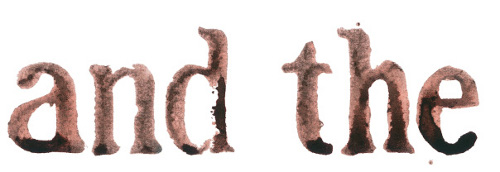
I began collecting boat and ship stamps when I was about 10 years old. Some of these stamps have ended up in Jonathan collages.
Okay, back to work. As you can see, I’ve made quite a mess.
I’m almost finished, though. It’s taken me five days to get the illustration to this point, so I’m anxious to be done.
The last step is to ink the drawing. I use nib pens and brushes to draw. I mix red and black to make a rust-colored ink. I add water to vary its strength.
And (ta-da!) here is the finished piece. Hooray, I’m done!
Thanks for reading! I hope you’ve enjoyed seeing a little bit about my process. I’ll leave you with some of my favorite images from Jonathan and the Big Blue Boat.
Thanks again to Phil. I’d be terribly remiss if I didn’t show you the book trailer for this one. It’s lovely and includes music Phil composed himself. Enjoy.
JONATHAN AND THE BIG BLUE BOAT. Copyright © 2011 by Philip C. Stead. Published by Roaring Brook, New York. All images (with the exception of the Creamed Tuna Fish cover) used with permission of Mr. Stead.
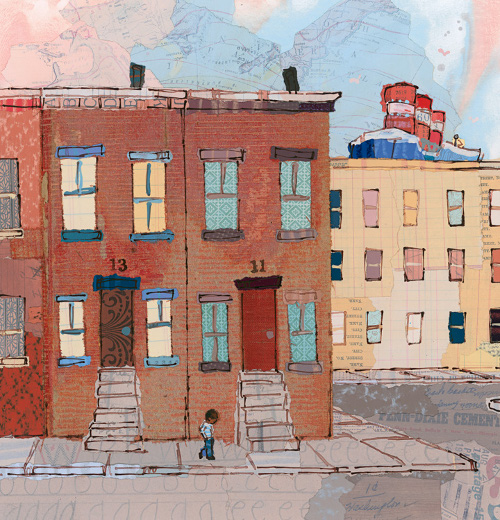
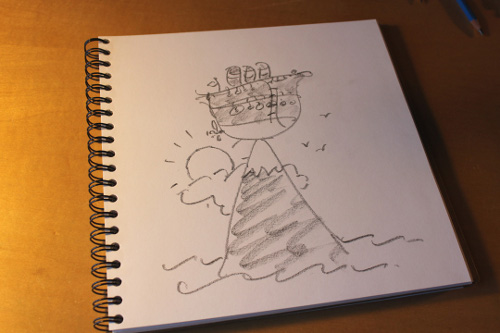
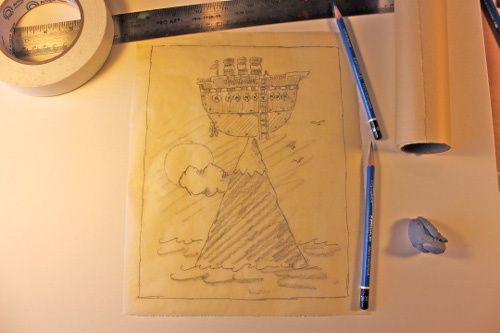

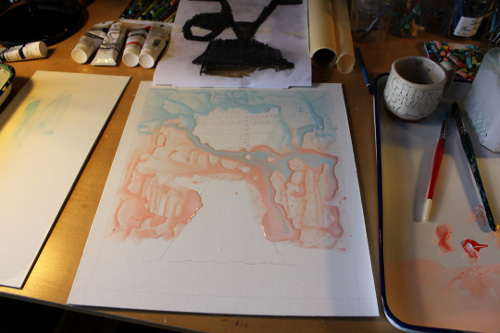

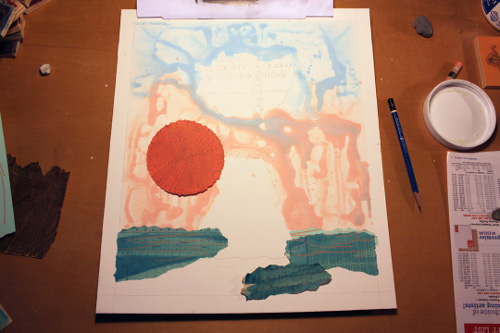
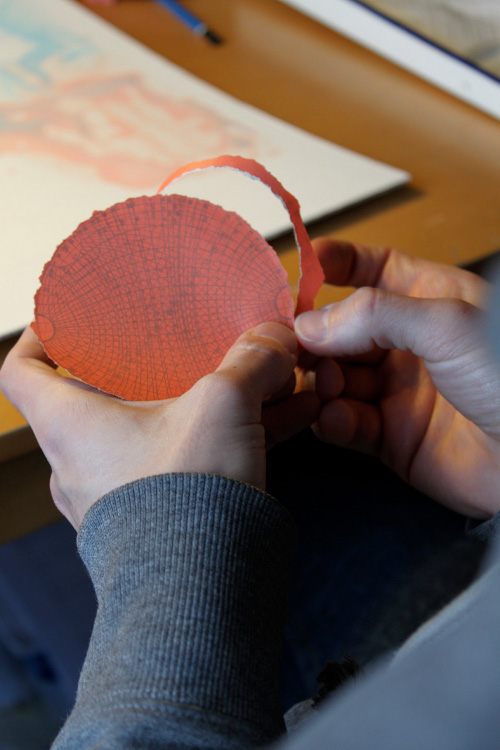
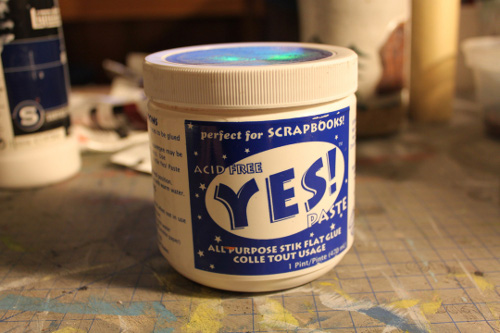


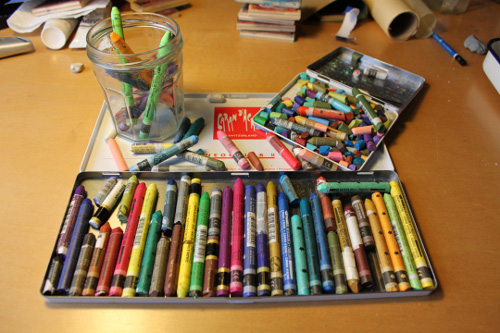
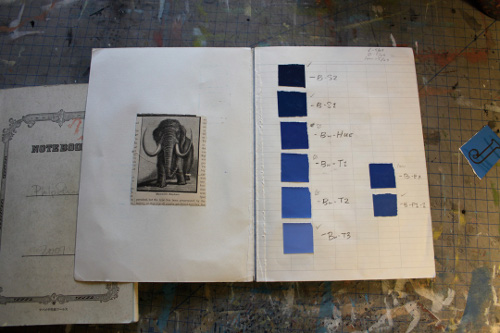
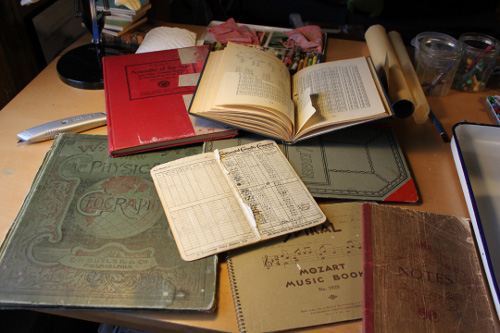
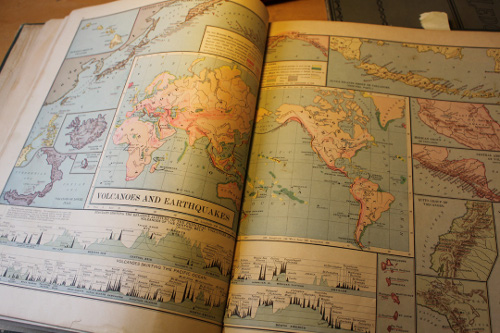
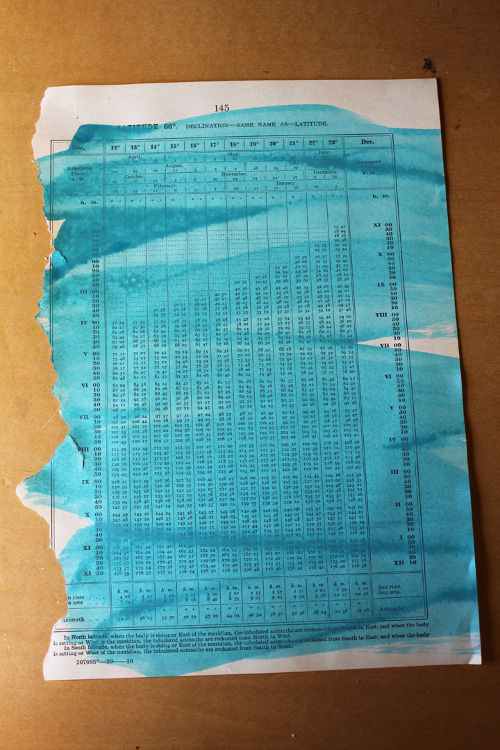
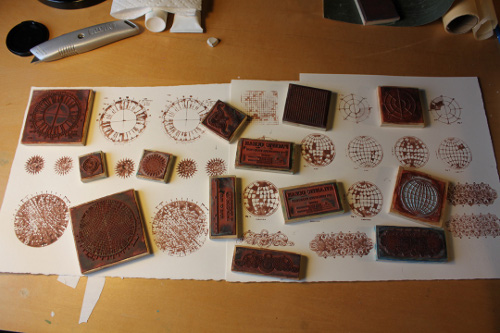
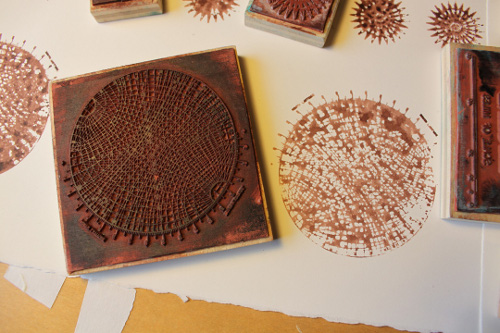
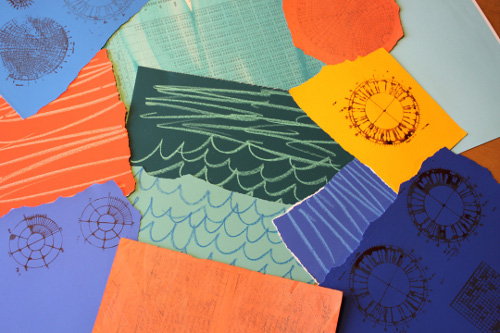
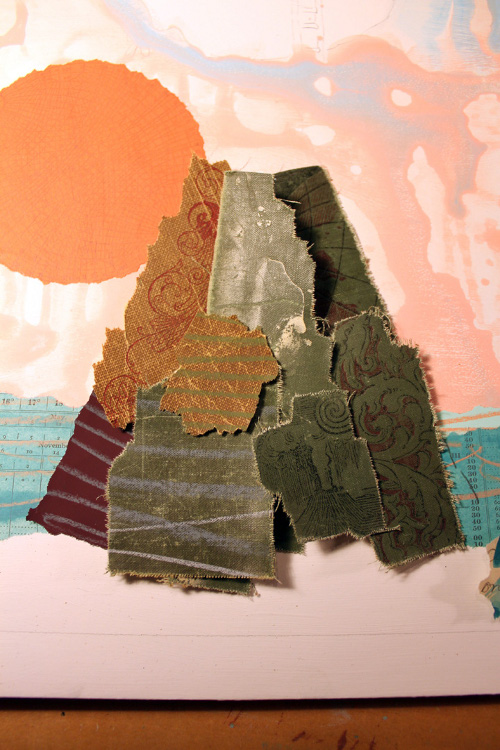
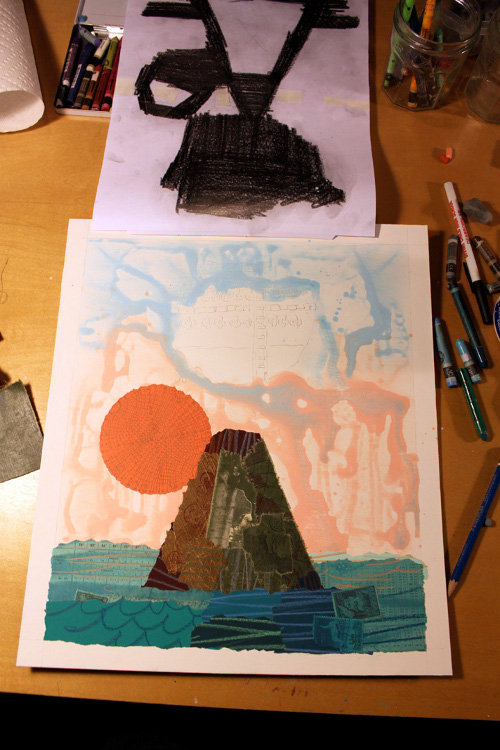
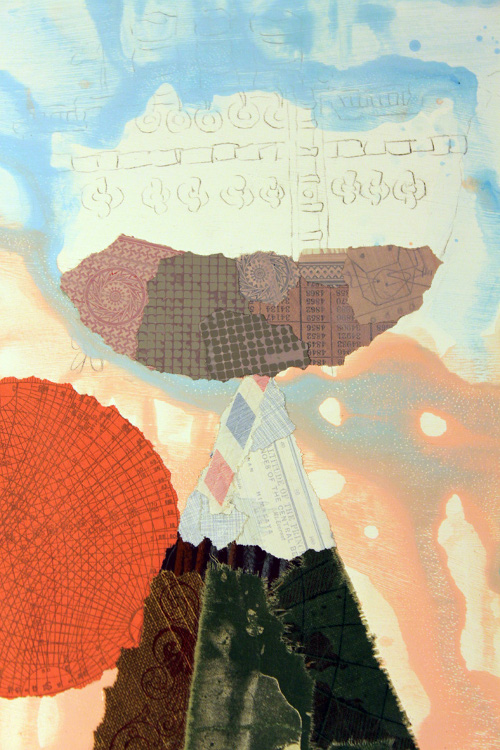
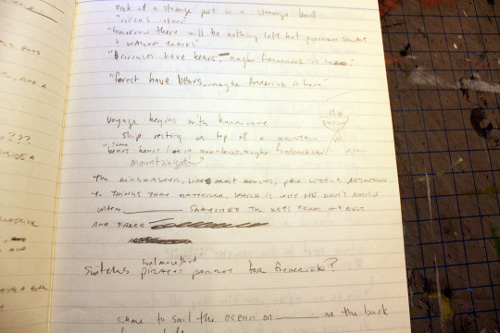
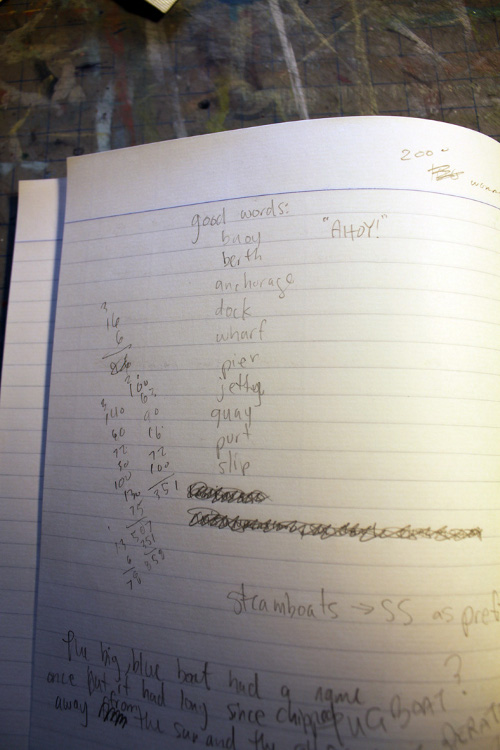



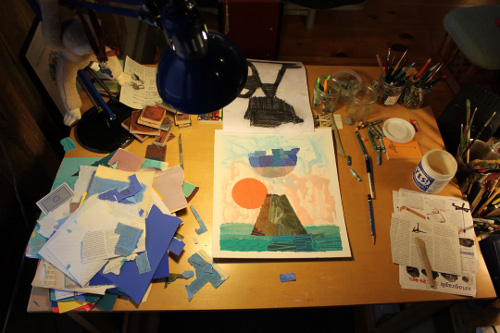
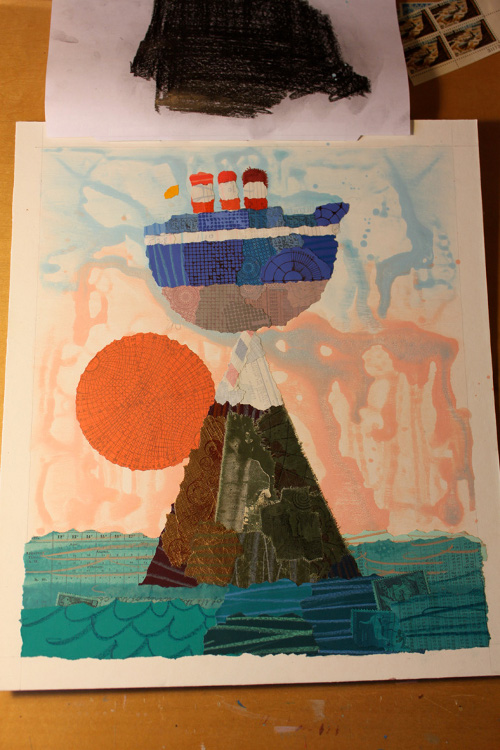
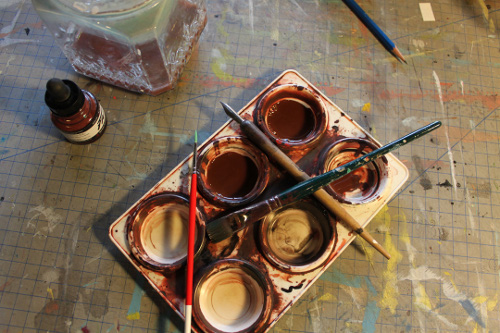

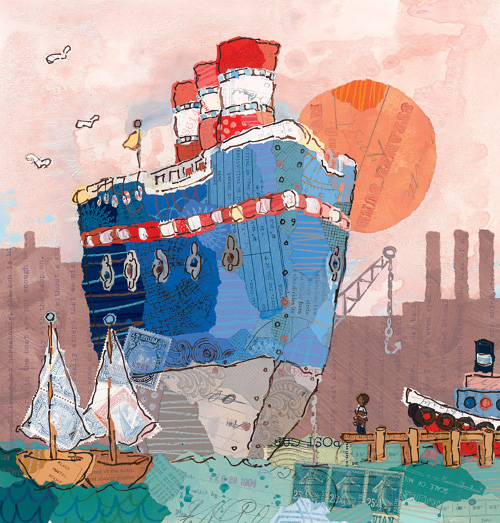
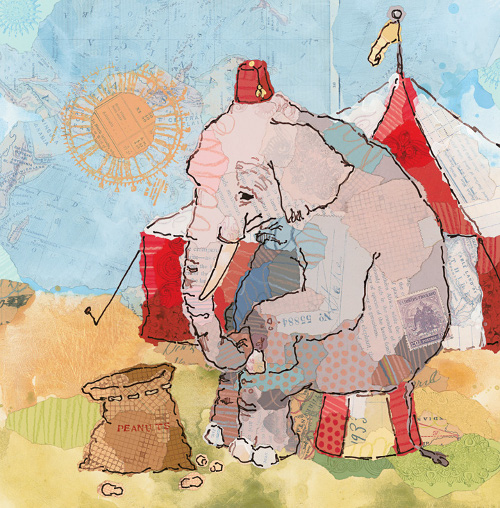
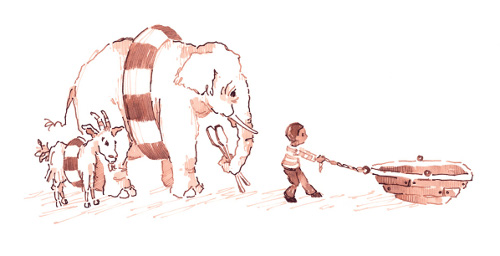


This post is wonderful! I gobbled it up. Thank you and more please! 🙂
Wow. Beautiful. And that coffee mug!
Fascinating. I love seeing the whole artistic process deconstructed. Thank you.
Thank you for posting about this wonderful book. The imagery is absolutely beautiful. As you mentioned it’s hard to move away from the images. There is so much going on between color, texture and line. A special thanks to Philip for sharing all that goes into his work. I’m so looking forward to reading about Jonathon’s journey.
In an age when most illustrators are doing this kind of work by scanning everything and putting it together in photoshop…it is nice to see a more hands-on approach. The time and thought it takes really shows in the final product. Thank you also for showing all of the behind-the-scenes steps. Maybe this can be a regular feature?
I love Jonathan’s collages! Thanks for sharing so many process photos. Can’t wait to see the book!
OOps, I meant Philip’s collages and Jonathan’s boat! 🙂
Incredible! What a wonderful way to start the week.
“Erin took this picture of me tearing out the sun” is the Best Photo Caption Ever.
What a fascinating process! Thanks for sharing!
This was an amazing post. I can’t wait to get this book! Thank you so much for this!
Wow. I just loved that!
It’s so incredible seeing the detailed process behind the finished product. I’d be so nervous about adding the last layers and details to something that I’ve already put so much work into. Beautiful illustrations, and I loved the book trailer, too.
Can’t wait to check it out in June!
Also, happy to see he has my favorite watercolor crayons. Love them!
So much fun to see Mr. Stead’s creative process. In addition to admiring the beautiful collage, I enjoyed seeing his brainstorming of word lists to create the text!
Gorgeous post, thanks!
[…] Seven Impossible Things Before Breakfast a blog about books « Teddy Bears Over Toasters: Or, Philip C. SteadVisits and Brings His Own Kickin’ Coffee Mug […]
WOW, I — wow. I am NOT patient. This is not a huge surprise, but the steps that go into this — having to get up and walk away, having to fiddle with things and put them here and there and do other things — I don’t think I have that kind of will, nor vision. And yet: the process is so intriguing, and I LOVE that he gave us pictures of each stop along the way. Thank you. What fun.
I loved this post! Thanks.
Jules,
WOW…just WOW!
Philip,
Thanks so much for taking us through your artisitc process!
P.S. Jules, you are so right about some people thinking children should be weaned from pictures too soon. When I was a school librarian, I often read picture books aloud to our fourth graders–and they loved it!
Thanks for visiting, everyone, and sharing this with me.
Elaine, I’m not surprised, seeing as how you are one of the country’s greatest teachers. Jack Gantos spoke two weeks ago about using picture books with high schoolers, something I also support. As he said, if you think they aren’t going to enjoy some of the more sophisticated ones, you’re in for a surprise. (And if I were an art teacher?? I’d use these like crazy to talk about medium, technique, etc.)
Thank you for being so open and for sharing this amazing process. Beautiful! I can’t wait to see the book in person.
I think I saw he composed the music for the trailer too, right? Amazing!
Thanks so much for sharing. I love the colors and the process and can’t wait to run to the store for my own copy soon.
Kristin, yes. He did. Check this out.
[…] all about the process he used to make the wonderful collage-y, watercolor pictures in this book here at Seven Impossible Things Before Breakfast. (Really–don’t miss this post if you’re at all interested in art and […]
Would you please consider publishing your works in BIG BOOK format for all those storytime children and their adults who appreciate how illustrations are as wonderful as the stories? Your illustrations are amazing.
Have been sharing this book around with my patrons at the library, and with my artist friends. LOVE this in-depth presentation of how Philip does the illustrations. WE LOVE his work. So glad I bought this book, Can’t wait for the next one. Well done, to you both.
[…] at pretty much all times and sends me stuff like what you see in today’s post (and the goodness he sent last year) […]
[…] sends me these fully-formed pieces on the creation of his books. (See: Last year’s, or even 2011′s.) I can take no credit here. If I ask someone to visit this site, I’m willing, needless to […]
I just read A home for Bird to my 3 yr. daughter. I thoroughly enjoyed it. The frogs concern for the bird was what got me. Your illustrations were beautiful and I will be using them for Art lessons for my children as well as this mini lesson here. I have an 11 yr. old daughter who is seldom without paper and pen. I look forward to looking through all your blogs and finding more of your books at the library to read. Thanks!!!
I found this page while surfing for inspiration for a project. I have been captured by Phil’s wife, Erin’s work on few occasions. Today I investigated the creative Stead team and found this eloquently written blog by Jules. Thank you Phil for sharing your engaging creative process that has lit a fire in me like nothing else has. I also would like to thank your talented wife who’s work I have long admired.